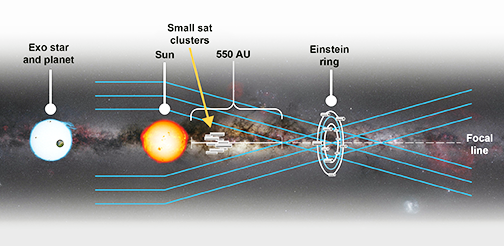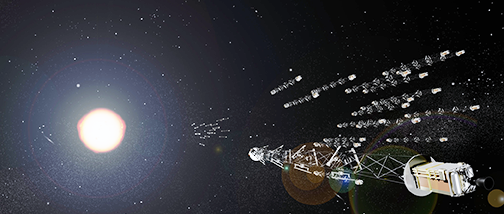

In a new development in the search for potentially habitable planets far beyond our solar system, NASA’s Jet Propulsion Laboratory (JPL) and The Aerospace Corporation (Aerospace) are conducting a study to further develop an innovative deep-space concept that relies on a solar gravity lens (SGL) to enable enhanced viewing of exoplanets.

The SGL mission layout infographic.
Image is courtesy of The Aerospace Corporation.
The SGL would provide 100-billion optical magnification, allowing it to show details as small as 10 kilometers across – similar to being able to spot something the size of New York City on an exoplanet. According to Einstein’s theory of relativity, light traveling through space will bend if it passes near sufficiently massive objects. This means that distant light will bend around the periphery of the sun, eventually converging toward a focal region as if it had passed through a lens. The SGL mission would send spacecraft to that region to view the focused light.
Navigation and propulsion technologies will need to keep the sensors on the spacecraft flying in the one-mile-wide line that contains the light from the exoplanet. The round-trip communications link of six light days will make ground control of the spacecraft impractical, so the spacecraft will need to be adaptable and able to learn from experience.

To undertake the two-year SGL study, Aerospace was awarded $130,000 from Phase II of NASA’s Innovative Advanced Concepts (NIAC) program through a contract with JPL in Pasadena, California, which leads the overall NIAC study.

Image is courtesy of The Aerospace Corporation.
Last year, Aerospace and JPL engineers participated in a technical brainstorming session at Aerospace’s Innovation Lab (iLab) to discuss the SGL concept. iLab fosters the development, acceleration, and transfer of new technologies that are critical to its customers. iLab researchers are currently developing solutions to unique engineering issues such as position, navigation, and timing (PNT); trajectory analysis; propulsion; communication link budget; and power distribution. That knowledge and technology is applicable to the SGL concept.
Executive Comments
Steve Isakowitz, Aerospace’s president and CEO, revealed that the SGL concept may become part of the scientific quest to explore the cosmic neighborhood. The team has leveraged an incredible array of groundbreaking technologies that have applications that go beyond exoplanet exploration. They will serve future national security, civil, and commercial missions that will keep our nation at the cutting edge.
Tom Heinsheimer, Aerospace’s technical co-lead for SGL, stated that SGL requires placement of an array of detectors that starts to observe the light from exoplanets once they arrive at a distance of approximately 50 billion miles or 550 astronomical units (AU) away from Earth. To get to that solar gravity line, the swarm of spacecraft will need to use a solar sail to fly out of the solar system at a velocity of more than 75 miles per second.
Henry Helvajian, Senior Scientist in Aerospace’s Physical Sciences Laboratory and technical co-lead of SGL, added that mission functions are distributed among the spacecraft so that some units could be dedicated to shepherding the entire swarm to their destination. The technologies involved in the distributed swarm — longevity, agility, autonomy, and self-learning — could revolutionize the space industry as a whole and significantly advance national security space objectives.

